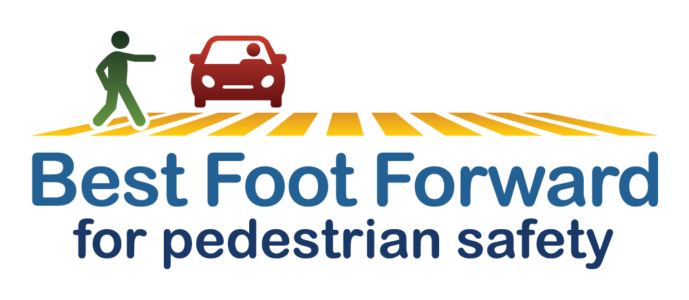As part of FDOT’s Target Zero initiative, Polk and Lake Counties have each recently selected…

Thanks to Tony Calabro as He Retires from Best Foot Forward Program

For more than 21 years, Tony Calabro has been making Central Florida safer by doing something as simple as crossing the street. Well – maybe not quite so simple – given the fact that the region is the most dangerous in the nation for people walking and biking. But after 12 years as an Orange County Sheriff’s Office (OCSO) crossing guard/trainer supervisor and nine more as a Best Foot Forward (BFF) data collector supervisor, Tony is stepping into retirement and deserves a big ‘thank you’ from all who cross any street in our region.
“Tony has been part of the BFF family from the very beginning, and we’re grateful that he chose to give back to the community for nine more years after retiring from his crossing guard supervisor post,” said Emily Hanna, Bike/Walk Central Florida executive director. “We’ve all benefited from his knowledge and dedication.”
 Emily Hanna, Casselberry’s Kelly Brock and Sgt. Blunt, and Tony Calabro
Emily Hanna, Casselberry’s Kelly Brock and Sgt. Blunt, and Tony Calabro
A passion for keeping students and all pedestrians safe
For people walking, Central Floridian streets are some of the most dangerous in the nation. For Calabro, these streets have been his office. He knows more than most how vulnerable pedestrians are in this region. Before becoming a data collector, he trained and supervised school crossing guards for the Orange County Sheriff’s Department for 12 years.
“I guess I’m supposed to retire from the Sheriff’s Department and not work at all and work on my suntan, but I guess not!” Calabro said when he retired from OCSO almost ten years ago.
Though Best Foot Forward has had several data collectors, Calabro has been a dedicated leader from the very beginning, when former executive director Brad Kuhn brought him aboard.
“Since I was a trainer and a supervisor for the crossing guards, [Kuhn] said this might be a good thing for people who were very knowledgeable about crossings and that it would be a perfect fit,” Calabro said.
“I just kept on going. I felt that it was a worthy organization, to try to get an awareness out to the people on what’s going on,” he said.
What Tony and data collectors do
The data Calabro collected is used by Best Foot Forward to track progress toward its mission: keeping pedestrians and drivers safe by getting more drivers to stop for people walking in marked crosswalks. Calabro helped collect baseline data before law enforcement goes out to remind drivers that they must yield/stop for pedestrians in crosswalks. He also records observations about the crosswalk: what are the markings on the street? Are the signs well-placed for drivers to see? Is there a safe place where officers and deputies can pull drivers over? Once Calabro has collected the pre-enforcement data, he recommends which crosswalks would benefit most from this event. Then BFF plans for the big day.
During Operation BFF, plainclothes officers and deputies walk across the street in the marked crosswalk. If drivers don’t stop as Florida law requires, they get pulled over and hit with at least a $164 ticket and three points on of their license. Calabro has also served as a decoy during these operations while the officers pull over and cite drivers who don’t stop.

“The data that Tony and other data collectors record is also used to make engineering recommendations to city and county officials,” said Hanna. “These numbers can act as the justification they need to fund new signage, fresh paint, safety islands, or other changes to crosswalks.”
Education, enforcement, and engineering are Best Foot Forward’s three E’s for getting more drivers to stop for pedestrians. Calabro’s data most directly impacts the enforcement and engineering parts of BFF’s approach, but he is also passionate about the third “E”: education.
Educating drivers and pedestrians alike, Calabro said, is the best way to make Central Florida’s streets safer.
After years of experience, he notes that children are particularly vulnerable at crossings. Most mornings, they have a crossing guard ready to stop traffic for them with an on-demand stop sign.
“Now you have to let the children know that when they’re out there, when it’s not school time and they’re on their own, that they’re aware that there’s not going to be a stop sign, or somebody out there stopping the vehicle,” Calabro said.
Drivers should also know the impact distracted driving can have, he says.
“A lot of times you see signs, but you don’t pay attention to the signs,” Calabro said. “You can have flashing lights going off, and people are not aware of it.”
Though the dangers of his job do not escape him, Calabro is optimistic. He says that Best Foot Forward is having a positive impact on pedestrian safety.
“In the last probably year or so, it seems like more vehicles are stopping further away from where I step out there,” Calabro said. “Drivers are more aware now, of the people going out there. [Pedestrians are] stepping on the crosswalk, they have to stop.”
Since 2012 Calabro and Best Foot Forward have tracked an increase in the number of drivers stopping for people in crosswalks. Initially, only 17% of drivers stopped for pedestrians in marked crosswalks. Since that time, many crosswalks have been “retired” as well from the program because drivers are now stopping.
So, a big thank you to Tony Calabro for putting his best foot forward to make our streets safer for more than 21 years!





This Post Has 0 Comments